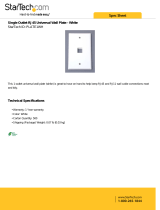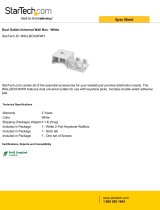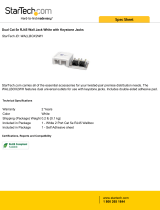Page is loading ...

INSTRUCTION / INSTALLATION SHEET
Home Entertainment Connection
Center (HECC 7.1)
IS-0357 Rev. O
301 Fulling Mill Road, Suite G
Middletown, PA 17057
Phone (800) 321-2343 / Fax (717) 702-2546
www.onqlegrand.com
©Copyright 2006 by On-Q/Legrand All Rights Reserved. Page 1 of 3
Source Input
Mounting Plate
with lyriQ™ Triple
Source Input Unit
(not included)
1. Introduction
On-Q/Legrand offers a Home Entertainment Connection Center (HECC) (P/N HT1000) which provides an
attractive, convenient interface to your entertainment center (see Figure 1). The HECC provides a single
connection point for all the remote cabling used in most home entertainment centers, including phone,
video, and data connections. Additional whole house distributed audio can be interfaced with the On-
Q/Legrand lyriQ™ Audio system or traditional speaker level audio distribution system with the 6 Room
Audio Module. The HECC is recess mounted and provides a low profile interface which includes a cover
that hides unsightly wire connections and aids in wire management.
2. Description
The HECC comes with a Source Input Mounting Plate (P/N 364886-01) , that enables the use of a
lyriQ™Single or Triple Source Input Unit (see Figure 2).
The HECC has a built in interface board for pre-wired Home Theater cabling (5.1, 6.1, 7.1). Also included is one universal Keystone style
phone RJ45 Insert, data RJ45 Insert, and three feed through "F" connector inserts for CATV, AUX, and Satellite. Additional universal Keystone
Inserts can be added for increased functionality.
The HECC employs a "User side" (front) and an "Installer side" (rear) designed to simplify wire terminations. The "User side" allows easy
access to telephone, data, CATV, DSS, and audio connection points. The "Installer side" allows easy access to the rear connection points by
rotating the top portion of the HECC outward and downward thus displaying readable connection diagrams. The cover is an attractive white
powder coated metal which allows cable access through the bottom and includes an installed plunger for quick access.
3.
Installation
Installation of the On-Q/Legrand HECC 7.1 is best accomplished at multiple times during new construction, at "Rough-in" before the drywall is
installed, and at "Trim-out" after the drywall is installed and painted.
NOTE: Please refer to the lyriQ™ Source Input Unit Instruction Sheets (IS-0319 and IS-0326) for additional module-specific
installation instructions (if applicable).
"Rough-in" Steps
A. The HECC should be located near the home entertainment area considering home owner access
needs, wiring, and cabling. Preferably it will be in a full stud cavity (16" center) and the stud cavity
should not be shared with HVAC, plumbing, or major high voltage cabling. Typical installation will be
centered on a wall. If the preferred mounting height is unknown, the HECC should be mounted at
outlet height.
B. Mount the pre-construction bracket (see Figure 3) to the studs with drywall screws, with the flanges
on the frame pointed out toward the drywall. Keep the bracket level to assure proper appearance
when installation is complete.
NOTE: The HECC is not firewall rated and should not be mounted in designated firewalls.
C. Cable Rough-in:
1) Surround Sound pre-wire (if applicable): 16/2 or 14/2 speaker wire should be run from the HECC location to each In-Wall/In-Ceiling
speaker pre-construction bracket location, leaving extra cable at both ends. The provided Speaker Brackets may be used to identify
the exact location of the speakers. There are clips on the speaker brackets to secure a coil of speaker wire, which will be connected
to the speaker at trim-out.
Figure 1
Figure 2
Figure 3

INSTRUCTION / INSTALLATION SHEET
Home Entertainment Connection
Center (HECC 7.1)
IS-0357 Rev. O
301 Fulling Mill Road, Suite G
Middletown, PA 17057
Phone (800) 321-2343 / Fax (717) 702-2546
www.onqlegrand.com
©Copyright 2006 by On-Q/Legrand All Rights Reserved. Page 2 of 3
2) One RG6QS cable should be run from a single gang outlet box or mud ring at the desired sub-woofer location to the HECC location,
leaving extra cable at both ends.
NOTE: The number of speaker wire runs will vary depending upon which theater format is being utilized.
3) At least one RG6QS cable and two Cat 5e cables should be run in the wall from the HECC location to the structured wiring
enclosure, leaving extra cable at both ends. Clearly label each cable as it is installed.
NOTE: The RG6QS cable is for normal distributed TV service. If Satellite service is planned, additional cables may need to
be run. The two Cat 5e cables are for phone and data services.
4) 6 Room Audio pre-wire (if applicable): run 16/4 or 14/4 high quality speaker wire from the HECC location to the volume control
locations and 16/2 or 14/2 from the volume control locations to each speaker location, leaving extra cable at both ends. Clearly label
each cable as it is installed.
5) lyriQ™ pre-wire (if applicable): run Cat 5e cable from the HECC location to the structured wiring enclosure, leaving extra cable at
both ends. Clearly label each cable as it is installed. Complete pre-wire of lyriQ™ system per lyriQ™ instructions.
NOTE: Always mark cables at both ends for easy identification at trim-out.
"Trim-out" Steps
A. At the HECC location, pull the RG6QS and speaker wires through the HECC mounting
bracket. Terminate the RG6QS cables with "F" connectors and attach to the appropriate
connectors for distributed TV service and sub-woofer service. The Surround Sound speaker
wires should be terminated at the screw terminals on the back of the HECC in accordance with
the appropriate speaker locations (5.1, 6.1, 7.1) as indicated on the HECC (see Figure 4).
NOTE: Follow this pattern for proper surround sound speaker connections to the User
side (5,5,5,5,5,6,7,.1): A) for 5.1 connect wires to connectors labeled "5" and ".1", B) for
6.1 connect wires to connectors labeled "5" and "6" and ".1", C) for 7.1 connect wires
to connectors labeled "5" and "6" and "7" and ".1"
Surround sound speakers are usually mounted on the sides of the room and not the
rear. For 5.1, the left and right speakers would be mounted on the left and right hand
sides. For 6.1, the speakers would be mounted on the left and right sides and the 3rd
speaker would be mounted in the center rear. For 7.1 the speakers would be mounted
on the left and right sides and the two additional speakers mounted in the left rear and
right rear positions (see Figures 5,6,7). In many situations it is necessary or desired to
substitute rear positions for the normally side mounted surrounds.
B. If using phone and data, terminate the Cat 5e cables from the structured wiring enclosure on the
universal Keystone RJ45 Jack Inserts and snap them into the back of the HECC.
C. Terminate any RG6QS cables with "F" connectors and attach them to the "F" feed through Inserts on the back of the HECC.
D. If using a 6 Room Audio Module, terminate the speaker wires from the impedance matching volume controls at the screw terminals on
the back of the HECC (see Figure 4).
E. If using a lyriQ™ system, terminate the Cat 5e cable from the structured wiring enclosure on a universal Keystone RJ45 Jack Insert and
snap the Insert into the back of the HECC. Using an RJ45 Jumper cable, such as P/N 363201-27, connect the lyriQ™ Source Input jack
labeled 'Audio Out' to the RJ45 jack which carries the lyriQ™ line level signal to the structured wiring enclosure.
F. Once all cables are attached to the back of the HECC, secure the HECC insert to the HECC mounting bracket using 4 drywall screws.
G. If using 6 Room Audio module, terminate the left and right speaker wires from the audio amplifier at the Source In connectors on the 6
Room Audio Module, using 16/4 high quality speaker wire.
NOTE: Impedance matching volume controls must be used to protect the audio source equipment.
Figure 4

INSTRUCTION / INSTALLATION SHEET
Home Entertainment Connection
Center (HECC 7.1)
IS-0357 Rev. O
301 Fulling Mill Road, Suite G
Middletown, PA 17057
Phone (800) 321-2343 / Fax (717) 702-2546
www.onqlegrand.com
©Copyright 2006 by On-Q/Legrand All Rights Reserved. Page 3 of 3
H. If using Surround Sound speakers, connect speaker wires to speakers keeping polarity constant so speakers are in proper phase.
I. If using an lyriQ™ system, a dual male to dual male RCA cable will need to be sourced to connect the line level stereo receiver output to
the RCA inputs of the lyriQ™ Source Input.
J. The RG6QS cable that was run from the HECC to the 1 port outlet (sub-woofer) location should be pulled through the single gang box or
mud ring, and terminated with an "F" connector. Once terminated, attach the cable to the RCA to "F" Connector Insert (P/N 364296-xx),
and attach the 1 port outlet to the single gang box or mud ring. A single male "RCA" to dual male "RCA" Y-cable, such as the subwoofer
RCA Y cable (P/N 364795-01), is available to attach the sub-woofer to the outlet.
K. Connect all equipment and devices as applicable. Always check for proper speaker polarity.
L. Sort and position the cables entering the front of the HECC to allow attachment of cover.
M. Hook cover on top of insert with plunger pulled out to open position. Engage plunger with the hole in the insert. Push in plunger to secure
cover to insert.
4.
Tips
A. To insure the speakers are installed "in-phase" follow a standard wiring pattern such as "+" on the HECC label goes to the red terminal
on the speaker over the wire with the label and "-" on the HECC label goes to the black terminal on the speaker over the wire without the
label. Wiring the speakers out of phase will decrease their sound output dramatically and cause significant distortion.
B. The opening should be level and square. It may be helpful to put the HECC Insert in the frame before tightening screws.
Figure 5 Figure 6 Figure 7
/







